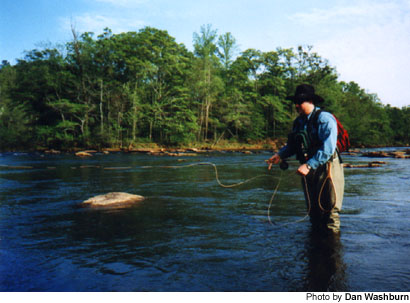
May 4, 1999 — Not until you’ve set the hook, won the battle and held the fish in your hands can you fully appreciate the thrill that is trout fishing on the tailwaters of the Chattahoochee.
But images of hooks not quite set, of battles lost and of fish that got away will stay with you.
They will haunt you on the drive back home.
They will visit you in bed as you try to sleep.
And they will inevitably draw you back to the river’s magical waters.
Again.
And again.
As you try to win the battle with the one that got away.
Thankfully, in Georgia this quest can be a continuous one. Nearly 60 percent of the state’s 5,000 miles of trout waters can be fished year round.
And the 44 miles of the Chattahoochee south of Buford Dam — the tailwaters — provide some of the Peach State’s most prolific trout fishing. Some estimate that each mile of the tailwaters is home to more than 6,000 fish. Those fish average 11-14 inches in length.
Buford Dam is an angler’s best friend. Not only did it create Lake Lanier, the dam also made trout fishing this far south a possibility.
Trout require cooler waters, between approximately 45 and 65 degrees, for survival. Since water is released beneath Buford Dam, the Chattahoochee is fed by the chilly water at the bottom of the deep Lake Lanier — thus allowing trout to live comfortably in the heart of the Deep South.
“It’s a heck of a fishery,” said Matt Pettepher, guide for my fly fishing foray, of the ‘Hooch’s tailwaters. “Even with the battles that it faces with development.”
Pettepher, who with his father, Rick, operates Atlanta Fly Fishing Outfitters in Roswell, should know. The 29-year-old, sporting a cowboy hat, a fu manchu moustache and a friendly Southern drawl, grew up fishing the ‘Hooch north of Atlanta.
He remembers the days when Roswell was still considered country, before it was enveloped by Atlanta’s suburban sprawl, before every car dealership known to man decided to move in.
But, like time, the ‘Hooch flows on.
Wade out into its tree-lined waters and escape to a simpler time.
“You could be anywhere in the world right here,” said Pettepher with a sigh and a shake of his head as he took in our surroundings. “It’s beautiful. You wouldn’t even know that highway 400 is right over yonder.”
We had entered the river at the Island Ford Unit, part of the Chattahoochee River National Recreation Area and about two-thirds of the way down the ‘Hooch’s tailwaters.
Immediately, Pettepher began to inspect the river’s insect population. A self-proclaimed fly-shop entomologist, he can speak at length about the life cycles of the mayfly and caddis fly, the trout’s insects of choice on the ‘Hooch.
Easily, Pettepher can determine the type, size and stage of development — larval, nymphal or adult — of the majority of insects on the water. This helps him determine what method of fly fishing to utilize.
We practiced, I was told, a technique called short-line nymphing, which mimics the subsurface nymph emerging into adult form. We fished using a dropper system, with an indicator (basically, a fancy word for a bobber) and two flies about 14 inches apart attached to the leader.
Pettepher, ready for anything, carries with him an arsenal of flies. How many?
“Well, I don’t know an exact number,” said Pettepher as he threaded the leader through the tiny loop on one of the flies. “But I can definitely say too many. Everybody carries more flies than they need.”
My afternoon began auspiciously enough. A 13-inch brown trout bit my second “practice” cast of the day — proving what Pettepher said repeatedly.
“Anybody can fly fish,” he said again and again. “There’s nobody that is too uncoordinated to fly fish.”
There were moments when I questioned this statement. Like the time one of my casts somehow managed to hook both of my legs.
But for the most part, Pettepher was right. It was easy — perhaps too easy. The hardest part is lightening up and letting the rod do the work for you.
The roll cast is a simple wrist motion. Rock the rod tip to the rear. Let the line pass behind you. Pause. And roll it upstream.
Once the indicator hits the water, mend the line to avoid drag. Move the rod tip downstream with the indicator. Following. Following. Following.
And the moment the indicator makes a move, go into hook-set procedure — because it’s either a fish or you’re stuck on the bottom.
I caught another 13-incher not too long after the first one. And then hours passed. A bite here. A bite there. Like hunters, we waded from hole to hole.
More hours passed. The setting sun now cast a sharp glare atop the water we had called home for half a day. And then it happened.
Following, following, follo … I didn’t need to see the indicator to know the trout had bitten the line. I shot my line hand away and down. I jerked my rod straight up. The hook was set.
I had him. And I could tell by his fight he was big, definitely bigger than either of my 13-inchers.
My heart raced. I had him.
And then suddenly, I didn’t.
I will forever be tracking the one that got away.
